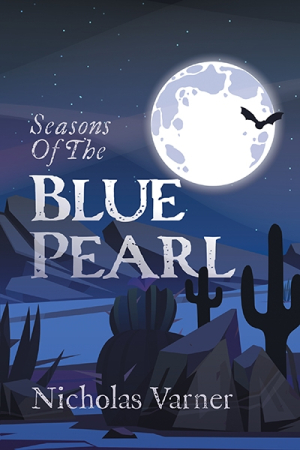Seasons of the Blue Pearl
In Nicholas Varner’s fantasy novel Seasons of the Blue Pearl, a young skeptic learns the importance of magic and looking beyond the obvious.
Whenever Mia’s parents try to teach her about her magical roots, she dismisses their lessons as stories for children and older people. But her perspective changes when the Arroyo Demons her parents warned her about become so bold that their existence can no longer be ignored or denied.
With the Arroyo Demons’ persistent attacks comes the discovery of an evil never before seen in the Fourth World. Mia and her family know that fighting with a united front is the only way to win against this evil and save Mud House Village from its greed-weakened state. Desperate and determined, they venture into the Northern Wilderness, from which no one has ever returned, hoping to find the legendary Flute People and gain their support.
Although the story is narrated in English, its chapters are numbered in Spanish, and its characters have Spanish and Native American names. Mia, who is only fourteen, is courageous, quick to learn from her mistakes, and always ready to help, even if it means being trapped in another world. She grows from naivete, selfishness, and disobedience toward maturity, sacrifice, and leadership. And beyond her, the other central characters are alluring too. They’re developed with consistency, portraying valuable lessons throughout the book.
As the villagers prepare to battle evil forces from other realms, Mia’s uncle, Ho-e, spreads laughter and lifts the spirits of everyone whenever the situation looks bleak. Likewise, her uncle Ahiga is fearsome and instills confidence in those around him. Every member of Mia’s family plays a crucial role in ensuring the survival of the Fourth World. Other members of their village also hold down the fort by refusing to surrender to the Arroyo Demons. However, it isn’t smooth sailing: some villagers choose to follow Clah on his path of greed instead of working in unity to save their land.
In this exciting bildungsroman, more than physical prowess is needed to succeed. The villagers contend with howling winds sent to stop the mission; they scale mountains and persuade stones to reveal their knowledge. And in this vibrant world, even the rains have genders and nothing is ever as it seems. The language flows with poetic beauty, reminiscent of campfire and bedtime stories. There are glowing descriptions with sensory appeal as well. And while the sudden shifts in the narration between the present and future can be startling, they are also insightful.
Paying homage to different cultures and people, Seasons of the Blue Pearl is a fantasy novel in which battles are won through teamwork, perseverance, and sacrifice—not greed and doubt.
Reviewed by
Gabriella Harrison
Disclosure: This article is not an endorsement, but a review. The publisher of this book provided free copies of the book and paid a small fee to have their book reviewed by a professional reviewer. Foreword Reviews and Clarion Reviews make no guarantee that the publisher will receive a positive review. Foreword Magazine, Inc. is disclosing this in accordance with the Federal Trade Commission’s 16 CFR, Part 255.

